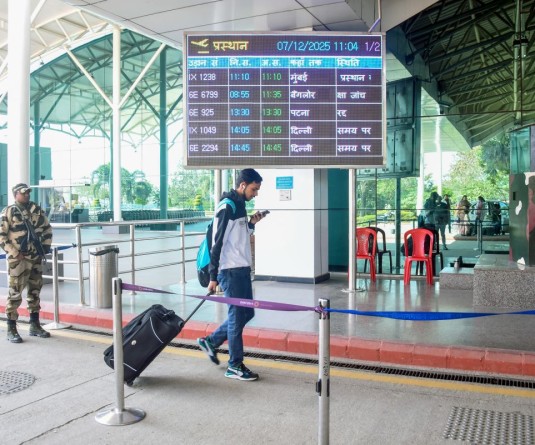
NEW Delhi, june 8 (Agencies): Terrorists trained like marine commandos to dive and slip through harbour protection systems could one day unleash havoc by planting underwater bombs or mines at a major port. This is no longer in the realm of fiction in the backdrop of the 26/11 terror strikes in Mumbai as well as last month’s Taliban attack on Mehran naval airbase in Karachi, both of which involved some training of the jihadis by Pakistani marine commandos. To tackle such threats, India is now also going in for “a major upgrade’’ of its harbour protection systems (HPSs) at the naval bases in Mumbai, Vizag, Karwar, Kochi and Port Blair, along with the ongoing security audit of ports, airfields, naval facilities, offshore installations and the like.
Top defence ministry sources say the plan is to “upgrade existing HPSs’’ and “plug gaps’’ to ensure that any nefarious activity by regular or irregular enemy forces are detected early and neutralized swiftly. Navy, of course, already has some HPSs like diver-detection sonars and underwater physical nets. “Scare chargers’’, which create sound waves to burst the eardrums of hostile divers or frogmen, are also used to secure areas if suspicious underwater activity is detected anytime. The upgrade plan will take them to an altogether different level. It involves “a composite HPS’’ for 24x7 wide-area surveillance through more advanced mobile nets, intrusion detection sonars, infra-red cameras, electro-optical, motion sensors and radars.
“Divers can now be armed with closed-circuit re-breather systems, which do not cause bubbles...that makes it all the more difficult to detect them,’’ said a source. “The composite HPS is to ensure that even a small cut in the nets or some other breach sets off alarms for responders to react in time and defuse the threat,’’ he added. Lessons have also been learnt from the way al-Qaida used a small explosive-laden craft to attack American destroyer USS Cole, which killed 17 sailors and injured dozens more, while it was harboured in the Yemeni port of Aden in October 2000. As part of the overall harbour security plan, the Navy will also procure 16 new coastal anti-submarine vessels which can operate outside harbours to keep enemy submarines at bay.
Navy’s new specialized Sagar Prahari Bal (SPB), one of the measures cleared after the 26/11 marine jihadis exposed gaping holes in India’s coastal security, has now also made a beginning towards protecting naval assets, bases and harbours on both west and east coasts. The first lot of the 15 fast-interception craft (FICs), which can effectively patrol almost up to 200 nautical miles, for SPB were delivered by French shipyard Chantier Naval Couach recently. These boats are in addition to the 80 FICs approved at a cost of over Rs 320 crore for the proposed 1,000-strong SPB, the deliveries of which will begin by 2012-2013. Sources said Phase-I of the critical coastal surveillance network will also be up and running soon. It includes 46 stations, with coastal radars, cameras, AIS (automatic identification systems) and other sensors mounted atop old lighthouses to dynamically locate and track vessels. Phase-II, with 56 additional stations, is to follow thereafter.
Top defence ministry sources say the plan is to “upgrade existing HPSs’’ and “plug gaps’’ to ensure that any nefarious activity by regular or irregular enemy forces are detected early and neutralized swiftly. Navy, of course, already has some HPSs like diver-detection sonars and underwater physical nets. “Scare chargers’’, which create sound waves to burst the eardrums of hostile divers or frogmen, are also used to secure areas if suspicious underwater activity is detected anytime. The upgrade plan will take them to an altogether different level. It involves “a composite HPS’’ for 24x7 wide-area surveillance through more advanced mobile nets, intrusion detection sonars, infra-red cameras, electro-optical, motion sensors and radars.
“Divers can now be armed with closed-circuit re-breather systems, which do not cause bubbles...that makes it all the more difficult to detect them,’’ said a source. “The composite HPS is to ensure that even a small cut in the nets or some other breach sets off alarms for responders to react in time and defuse the threat,’’ he added. Lessons have also been learnt from the way al-Qaida used a small explosive-laden craft to attack American destroyer USS Cole, which killed 17 sailors and injured dozens more, while it was harboured in the Yemeni port of Aden in October 2000. As part of the overall harbour security plan, the Navy will also procure 16 new coastal anti-submarine vessels which can operate outside harbours to keep enemy submarines at bay.
Navy’s new specialized Sagar Prahari Bal (SPB), one of the measures cleared after the 26/11 marine jihadis exposed gaping holes in India’s coastal security, has now also made a beginning towards protecting naval assets, bases and harbours on both west and east coasts. The first lot of the 15 fast-interception craft (FICs), which can effectively patrol almost up to 200 nautical miles, for SPB were delivered by French shipyard Chantier Naval Couach recently. These boats are in addition to the 80 FICs approved at a cost of over Rs 320 crore for the proposed 1,000-strong SPB, the deliveries of which will begin by 2012-2013. Sources said Phase-I of the critical coastal surveillance network will also be up and running soon. It includes 46 stations, with coastal radars, cameras, AIS (automatic identification systems) and other sensors mounted atop old lighthouses to dynamically locate and track vessels. Phase-II, with 56 additional stations, is to follow thereafter.






